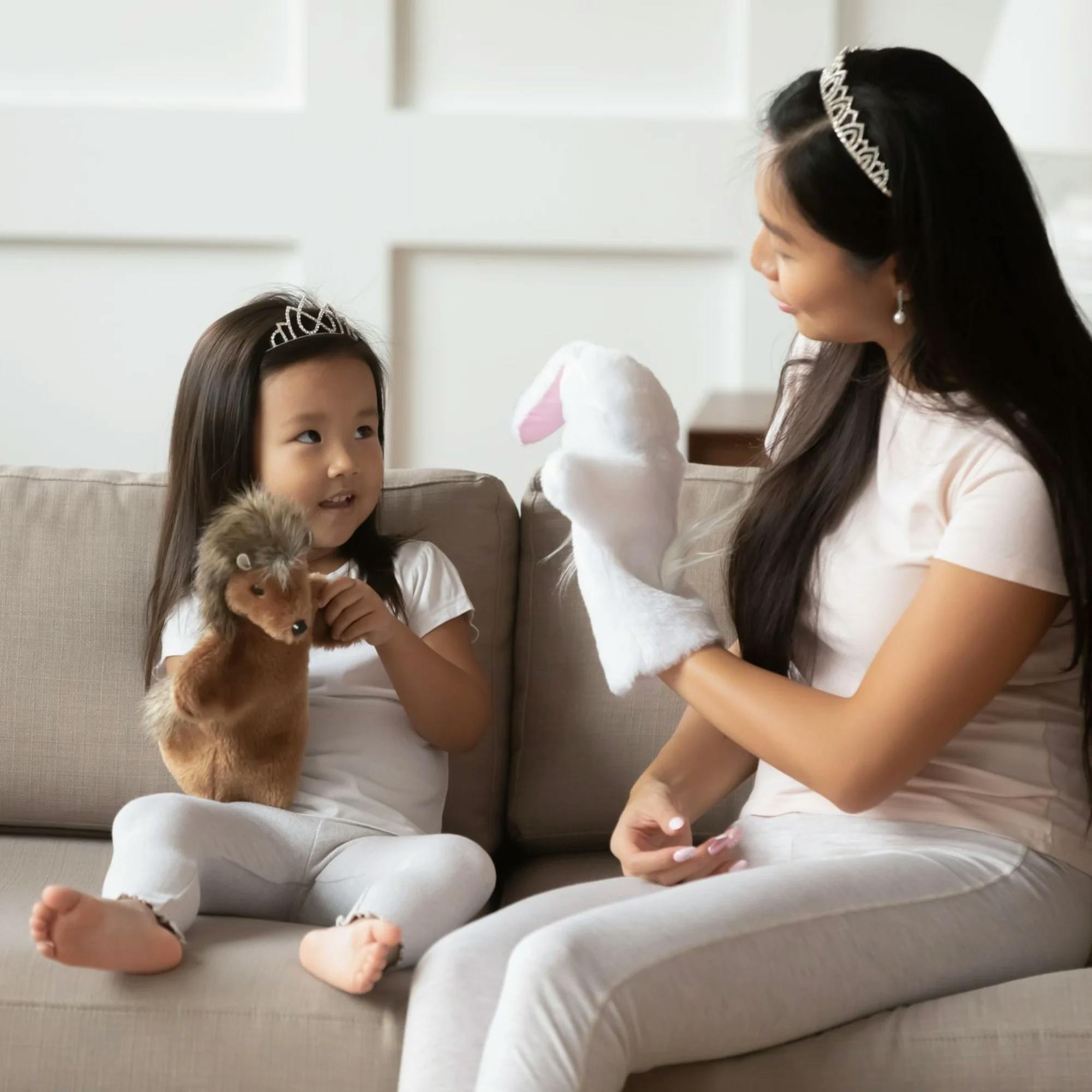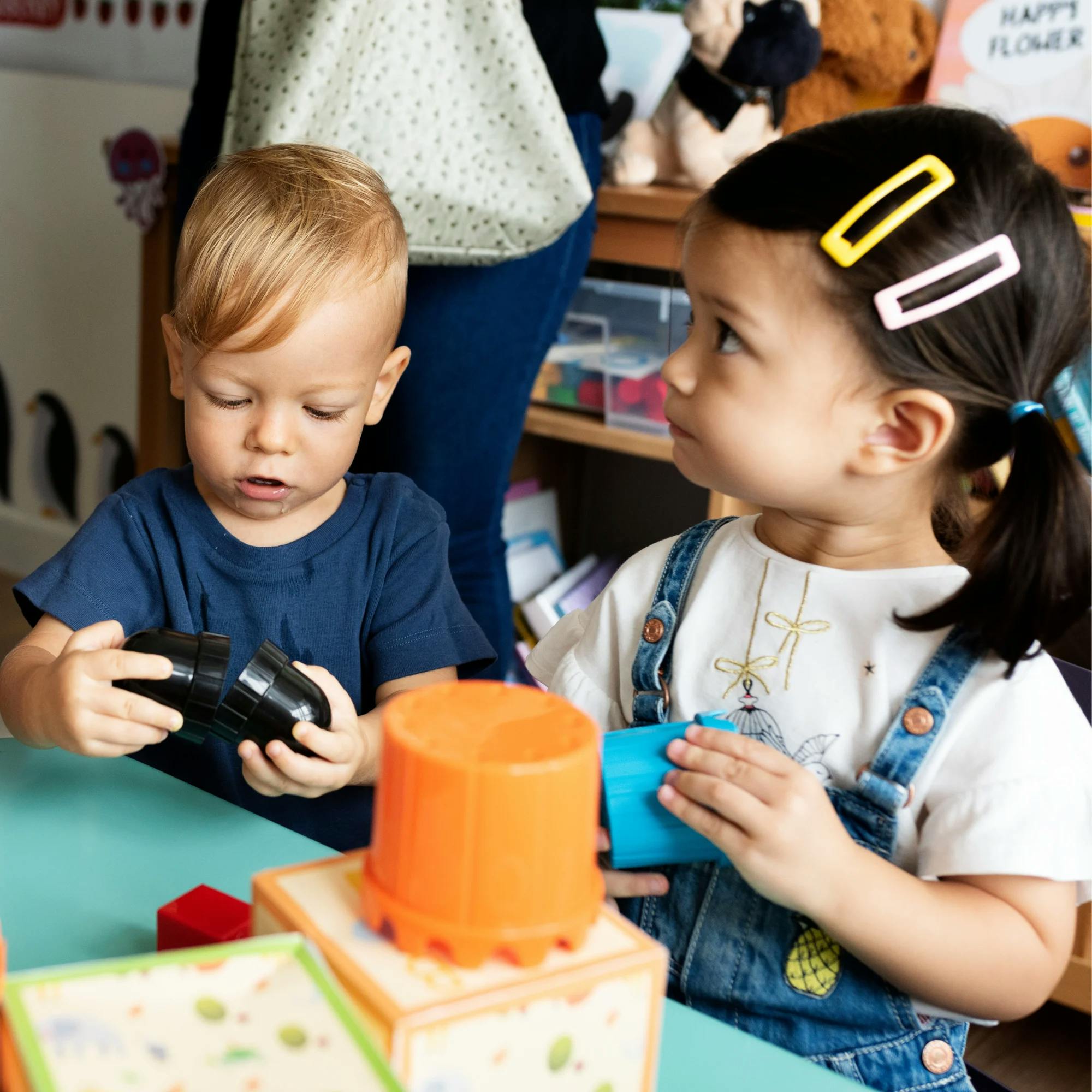
What Is Expressive Language? Definition and Developmental Milestones

For the longest time, my toddler’s vocabulary consisted of a few words—“iv,” “tal,” “ee,” and “wa.” These were his go-to expressions for almost everything, and while they were adorable, they also made it clear that he was a bit behind in developing his expressive language. Learn more about what expressive language is, language milestones by age, and practical at-home and classroom strategies to help your child strengthen their expressive language skills.
As a mom of a toddler with expressive language delay, I know firsthand how frustrating it can be when your child wants to say something but struggles to use words. For two years, my son has been working on how to say new words and form sentences. I can see that he knows exactly what he wants to say, even when he can’t get the words out. It’s challenging for both of us: For him, because he can’t always express what he feels, and for me, as I balance the urge to step in and help with the need to give him space to practice and grow on his own.
The way we share our thoughts, ideas, and feelings is called expressive language. It involves using new vocabulary, forming sentences, telling stories, and communicating our wants and needs. For children with expressive language delay, these skills may take more time and support to develop.
In this guide, we’ll explore what expressive language is, what developmental milestones to look for, signs your child may benefit from extra help, and how speech therapy can support your child’s ability to communicate.
How to use this guide
Take a few minutes to skim the definitions and key terms. This will help you understand what expressive language means and why it matters for communication.
Find your child’s age range or developmental stage. Choose two or three play-based strategies to use during your daily routine.
Keep a simple log of new words, phrases, or communication attempts. Share the achievements with your child’s speech therapist and teacher so everyone can offer the right support. Additionally, let other family members know so they can prompt and encourage the use of these words.
Progress doesn’t always follow a straight line. Some days your child might surprise you with new words or longer sentences, while other days might feel slower.
Curious or concerned?
Our free screener is tailored by age and covers all areas of speech, language, and feeding. Find out if your child might need speech therapy.
 Screener for children
Screener for childrenWhat is expressive language?
Expressive language is how we express our thoughts, feelings, wants, and needs with others. It involves both verbal and nonverbal communication, such as using words, gestures, facial expressions, writing, pointing, or an augmentative and alternative communication (AAC) device. Expressive language is how children communicate during play, tell stories, ask and answer questions, and label their feelings.
Core expressive language skills involve learning new words, combining words to create sentences, and using proper grammar. These skills begin developing from birth, starting with a baby’s first cries as a form of communication. Skills gradually develop as toddlers learn to express themselves with other forms of communication.

Receptive vs. expressive language
While expressive language involves communicating ideas, thoughts, and feelings, receptive language focuses on understanding them. This includes following directions, answering questions, understanding stories, and making sense of words and sentences.
These skills are closely connected, and they’re both needed in order to communicate with others. “Receptive language comes first. Children need to comprehend what’s being said before they can respond,” explains Alexis Irazoque, MS, L/SLP, speech-language pathologist at Expressable. She adds that it’s common to see a gap between what a child understands and what they can express. “Parents often say that their children understand everything but aren't using words to communicate back.” Working with a speech therapist can help bridge that gap between understanding and communicating.
Developmental milestones: Expressive communication by age
Every child develops expressive language at their own pace. However, these milestones can help you track progress and identify when your child might need more support.
0 to 12 months
0 to 3 months: Babies use different types of crying to communicate basic needs like hunger, discomfort, pain, or tiredness.
3 to 6 months: Babies begin experimenting with their voices, using squeals and changes in pitch. They begin to babble sounds like “ma.”
6 to 9 months: Babbling becomes longer and more complex, without associated meaning. For example, “ma” becomes “mamama.”
9 to 12 months: Babies begin imitating sounds and forming intentional, meaningful words like “mama” or “dada.”
12 to 24 months
12-18 months: Toddlers start to shake their heads “yes” or “no,” or say spontaneous, meaningful words like “milk” when thirsty. Your toddler may begin to use consonant sounds, which are individual speech sounds to form words, like /b/, /d/, or /m/. “Consonant sounds are important for expressive language because they help children clearly articulate words so others can understand their thoughts, needs, and ideas,” says Irazoque.
18 to 24 months: A toddler’s vocabulary expands to 5 to 10 words. They may begin to use two-word phrases like “more milk.”


2 to 3 years
2 years: Toddlers engage in short conversations, use pronouns (me, my, mine), and have an expanded vocabulary of around 50 words. They may also begin to express their feelings with words, answer simple questions, and request things.
3 years: Toddlers begin to form three- or four-word sentences, like “Where is Mama?” They will also start to pluralize words, use verbs with “ing” (like “walking”), name the actions (or verbs) in pictures or books, and say their own name.
4 to 5 years
4 years: Children can name their feelings (happy, sad). They can answer questions, join in conversations with both adults and children, and talk about something that happened during their day.
5 years: Children begin to tell short stories, form more mature and complex sentences, and use correct terminology for the vocabulary they use.
Signs your child may need extra support
If your child is having difficulty with expressive language, you may notice it right away or it might be more subtle. Either way, it’s important to recognize the signs that your child might need help. Below are several signs that your child may be struggling to express themselves and could benefit from support.
Early signs of expressive language difficulties (18 to 30 months)
Limited use of gestures like pointing, waving, or reaching to communicate
Trouble understanding simple words or directions
Slow growth in vocabulary or difficulty combining words (says “juice,” but not “more juice”)
Later signs of expressive language difficulties (preschool and early school age)
Difficulty forming sentences correctly, such as leaving out words or mixing up the order of words
Trouble asking questions or expressing needs
Challenges with retelling stories, singing songs, or participating in conversations
These signs may point to an expressive language disorder. Working with a speech therapist can help your child develop these skills, while also boosting their confidence and self-esteem as they grow in their ability to communicate.

When to seek an evaluation
If your child is not meeting expressive language milestones, your pediatrician may suggest an evaluation with a speech therapist. During an evaluation, the speech therapist will review your child’s medical history and take a close look at how their mouth moves when they talk. They will also observe your child’s use of words, gestures, and other ways they communicate, as well as their language comprehension.
If the therapist thinks your child could benefit from speech therapy, they will create a personalized care plan. This plan will explain how often your child should attend sessions, what each session might look like, and the goals you’ll work on together.
Free speech check
How well is your child speaking for their age? Find out with our free 5-minute online screener. No signup required, just answers.
 Start the screener
Start the screenerWorking with a speech-language pathologist (SLP)
A speech therapist works with your child at their own pace, based on their age and developmental level. Speech therapy for kids is designed to be play-based, fun, and engaging. Your Expressable speech therapist will help your child build new language skills using toys, games, videos, favorite characters, books, sports, or music. Sessions are child-led and follow your child’s interests (like referring to their favorite superhero or princess) to make learning motivating.
Speech therapy works best when a parent or caregiver is able to attend sessions. That way you can learn directly from the therapist how to help your child practice at home. So much language development can happen during everyday routines with family members. The more you practice these new skills with your child, the faster they’ll learn!
Your speech therapist will track your child’s progress using a variety of tools and observations to measure growth over time, such as:
Language sampling: Listening to a child during play, conversation, or structured activities to see how many words they use and how they form sentences, express themselves, or tell stories.
Observing functional communication: Watching a child express their wants, needs, and feelings in everyday routines.
Tracking progress: Each child has individualized goals, and progress is tracked as these goals are met.
Standardized assessments: Some children may complete periodic testing so their speech therapist can measure improvements in vocabulary, sentence structure, and storytelling skills.


Home strategies to build expressive language
For new language skills to stick, they should be practiced every day. That’s why parents are such an important part of speech therapy. Your therapist will provide guidance and strategies to help you work on language skills at home during everyday routines. This can reinforce and strengthen what your child learns in therapy–and help them make faster progress. Here are some examples of home strategies based on your child’s age. Note that certain strategies—like choice making—can be used at any age to promote early language development.
1 to 3 years
Naming objects: Guide your child to name familiar items in your home, like their bed, highchair, and toys. For example, while getting dressed, you might say, “Here’s your shirt. Blue shirt.” Repeat words often and pause to give your child a chance to imitate you.
Requesting skills: Encourage your child to use words or gestures to ask for what they need. For example, you can help your child to say or make the sign for “more” when they want more of something.
Simple two-word phrases: Model everyday short phrases that your child can imitate, such as “shoes on,” “my shoe,” or “more juice.”
3 to 6 years
Play sabotage: Create small “problems” during play that require communication. For example, place your child’s favorite toy in a container they can’t open. Then model the words to open it, like “help” or “open box, please.”
Choice making: Offer your child two options for snack time or two toys during play. Label each one clearly, and encourage your child to respond with a word or gesture.
Modeling language: Repeat your child’s phrases, but add words to create longer and more complex sentences. If they’re using two-word phrases (“give me”), model three- or four-word phrases instead (“give me the ball”).
6+ years
Grammar practice: Use everyday routines to correct and model proper grammar. If your child says, “I like that shirt more better,” you can respond with agreement and restatement, saying, “I like that shirt better.”
Sequencing and storytelling: Help your child practice organizing their thoughts by asking them to describe routines or events.
Narrative expansion: Encourage your child to retell stories from their day at school or a book they read. Prompt them with open-ended questions like, “What happened next?” or “Who did that?”
Your Expressable speech therapist will explain which strategies are best for your child and offer ongoing support between sessions. They’ll assign easy activities in your client portal for practicing expressive language skills with your child. You can also ask questions or get tips from your therapist via text messaging throughout the week.

How to support kids with special or different needs
Speech therapy works best when it is personalized and meets your child where they are. This includes supporting neurodivergent children, children from bilingual homes, and children who use AAC devices to communicate.
Neurodiversity
“Every child’s brain works differently, and that’s a natural part of human diversity,” says Irazoque. For neurodivergent children, speech therapy focuses on their strengths of communication, rather than trying to “fix them.” A neurodiversity-affirming speech therapist will build a warm, trusting relationship through play-based activities that the child enjoys. Irazoque explains that the speech therapist will join the child in their world, rather than expecting them to play or communicate in a “typical” way.
Bilingual homes
For children growing up in bilingual homes, speech therapists can support language development in all the languages your child is exposed to. This might include modeling words and phrases in each language. Speech therapists closely collaborate with families to
maintain a consistent, language-rich environment. This makes it easier for your child to practice and use their words both at home and in therapy.
AAC
For children who don’t use words to communicate, an AAC device can help them express themselves. Examples of AAC devices include communication boards, speech-generating devices, computer apps, picture books, drawing or writing, and other forms of nonverbal communication. A speech therapist can guide your child in using AAC for expressive language skills and teach caregivers, teachers, and family members how to use it as well.
Tips to work with your child’s caregiver
Your child’s caregivers or school teacher can help them build expressive language skills. It’s important to share your child’s needs with their teacher, since some challenges may not be immediately obvious. Your speech therapist can explain how teachers can help your child in the classroom, such as:
Using visual supports, like schedules, picture cards, routine charts, word walls, or gesture pictures
Labeling everyday items in the classroom
Repeating important phrases during school routines
Asking low-pressure questions to encourage your child to participate
Breaking instructions into smaller steps so they are easier to follow
Teachers and therapists can monitor your child’s progress together. “Therapists and teachers collaborate to observe how a child is using language in real-life classroom situations, then provide feedback to adjust strategies as needed,” says Irazoque. This teamwork helps ensure that the skills your child is building in therapy are reinforced and practiced throughout the school day.
Master list of supplies to keep at home
Your speech therapist will use a variety of fun tools and activities to help your child build language skills. These resources make it easier for your child to explore language, practice new words, and express themselves during everyday play and routines. At home, children can learn language skills using the toys and everyday household items they already have, but here are some suggestions:
Picture cards or flashcards
Kids’ books with clear, simple images
Writing and drawing materials
Puppets or dolls
Simple toys for pretend play, like a farm set, kitchen set, cars, or people figurines
Choice boards (a visual display with pictures or photos of activities, food, toys, or other items to help a child express what they want)
A low-tech AAC device like a core word board
Stickers


Frequently asked questions
What are examples of expressive language?
“Expressive language is how children share their thoughts, needs, and ideas,” says Irazoque. Expressive language examples include saying words, forming sentences, retelling stories, answering and asking questions, and using gestures to communicate.
What's the difference between expressive and receptive language?
Expressive language is using verbal and nonverbal communication to express thoughts, feelings, wants, and needs. Receptive language is understanding verbal and nonverbal communication. “Communication relies on both understanding language and using it to express yourself,” explains Irazoque. Speech therapy can help children turn what they understand into words, so they can communicate more clearly and confidently with others.
What is a lack of expressive language?
If your child is struggling to express themselves with verbal or nonverbal language, they may have an expressive language disorder. You may hear grunting or gurgling sounds instead of words. Your child may have difficulty forming sentences or gesturing to express their thoughts.
Which statement is an example of expressive language?
Examples of expressive language include:
Using words to ask questions, like “Where is my toy?”
Labeling things, such as saying “dog” for the family pet.
Using gestures or actions to communicate, like pointing to a cup of milk to show they want more milk.
Responding to questions, like “Yes, I played with Joey on the playground today.”
How do you know if your child’s expressive language is delayed?
Every child develops at their own pace. A speech therapist can help determine whether your child has a delay or an expressive language disorder. They will listen to and observe your child’s communication skills to see how they use words, form sentences, and express their thoughts using gestures. You can also take Expressable’s free online screener to see if an evaluation is recommended.
Key takeaways
Expressive language is how children share thoughts, feelings, and needs using words and gestures.
Your child may have an expressive language delay or disorder if they have slow vocabulary growth, difficulty forming sentences, or trouble retelling stories.
Speech therapy supports expressive language development through individualized, play-based strategies that engage and motivate your child. It works best when both parents and teachers are involved, so your child’s new skills can be practiced both at home and in the classroom.
A speech therapist can provide support for neurodivergent children, children from bilingual homes, and children who use AAC devices. They will tailor therapy sessions to meet each child’s unique needs.
How Expressable Can Help
Concerned your child isn't reaching age-expected milestones? Looking for communication support from a professional? Expressable is a national online speech therapy practice serving children and adults. We treat all major areas of communication and feeding, offer flexible hours including evenings and weekends, and accept most major health insurance plans. We’re proud to have earned more than 3,000 5-star reviews from our clients (4.9/5 average).
Our therapy model is centered on parent and caregiver involvement. Research proves that empowering caregivers to participate in their loved one’s therapy leads to better outcomes. That’s why we combine live, 1-on-1 speech therapy with personalized education and home practice activities for faster progress.
Communication is more than words. It’s how we share how we feel and show who we are. We’re here to help you or your child do just that.











